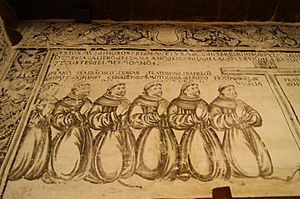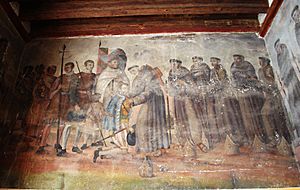Twelve Apostles of Mexico facts for kids
The Twelve Apostles of Mexico were a group of twelve Franciscan missionaries. They arrived in the new Spanish lands of Mexico, called New Spain, on May 13 or 14, 1524. They reached Mexico City on June 17 or 18. Their main goal was to teach the native people about Christianity. The Spanish conqueror, Hernán Cortés, had asked for these friars to help spread the Christian faith. Even though there were only a few of them, their arrival was very important. It marked the start of a big effort to teach Christianity to the native people in New Spain.
Before the Twelve Apostles arrived, another Franciscan friar named Pedro de Gante had already started teaching the native people in 1523. Fray Juan Galpión helped organize the group of Twelve Franciscans. Fray Martín de Valencia was chosen as their leader.
The group of Twelve included:
- Fray Martín de Valencia (their leader)
- Fray Francisco de Soto
- Fray Martín de Coruña (also known as Fray Martín de Jesǘs)
- Fray Juan Juárez
- Fray Antonio de Ciudad Rodrigo
- Fray Toribio de Benavente Motolinia
- García de Cisneros
- Fray Luis de Fuensalida
- Juan de Ribas
- Fray Francisco Jiménez
- Fray Andrés de Córdoba
- Fray Juan de Palos
Fray Juan de Palos was a lay Franciscan. He took the place of another friar who could not travel with the group. Fray Andrés de Córdoba was also a lay brother.
The most well-known of the Twelve was Toribio de Benavente Motolinia. He wrote many detailed accounts about the customs of the Nahua people. He also wrote about the challenges of teaching Christianity. His writings are very important for understanding this key time in Mexican history.
Contents
Missionary Work
The Franciscan Twelve received special instructions from their leader, Francisco De los Angeles. These instructions were given before they left for Mexico. A copy of these orders was brought with them when they arrived in 1524.
These instructions talked about what the Franciscan Twelve should expect. They mentioned the difficulties and even the possibility of death in their mission. The Twelve Franciscans were seen as similar to the first apostles in their goals. The orders also spoke about their duty to convert people to Christianity. They believed that New Spain was a place where God and the Devil were fighting. The native people, they thought, did not know about this spiritual battle. So, De los Angeles stressed that the natives needed the Christian faith that the Franciscans offered.
Where They Taught
The first efforts to teach Christianity in the Americas began in 1500 on Santo Domingo. That is where the Franciscan mission was officially started.
The Twelve Apostles of New Spain arrived in Mexico in 1524. They were greeted by Hernán Cortés, who had conquered the Aztec empire. Their teaching began in the Valley of Mexico and the Valley of Puebla. They chose these areas because they were important native settlements. In the Valley of Puebla, they chose Tlaxcala and Huejotzinco. These groups had helped the Spanish in their conquest of the Mexica. In the Valley of Mexico, Texcoco was an early site. Texcoco had also helped the Spanish and was once part of the Aztec Triple Alliance. Churubusco was another initial location.
How They Taught
Schools
Teaching native children was a very important part of spreading Christianity. So, schools became places of influence and control. After Cortés won his military battles, Texcoco became the site of a school. Three Franciscans started it, including Pedro de Gante. In 1524, the Franciscan Twelve followed de Gante's example. They set up schools in places like Tlatelolco-Mexico City, Tlaxcala, and Huejotzingo.
Pueblos de Indios
The "pueblos de indios" were special towns for native people. They were also called "reducciones indígenas." These were ways to bring native communities together in one place. The Spanish government started promoting these towns in the mid-1500s. They were created to make it easier to teach Christianity and to collect taxes more efficiently.
Mission Churches (Conventos)
The Franciscan Twelve started the idea of the "Mission church." These churches helped both the Roman Catholic Church and the Spanish Crown. In 1537, Pope Paul III issued a decree called Sublimis Deus. This decree stated that native people were not "savages." Instead, they were human beings with souls. It said they could understand and accept Christian beliefs. This helped to reduce the widespread enslavement of native people, though it did not end it completely.
Because of this, many religious groups sent friars to New Spain. This happened especially between 1523 and 1580. Groups like the Dominicans, the Franciscans, Augustinians, and the Jesuits were among them. These groups worked to convert the native people and spread Christianity. To do this, friars built mission churches, called conventos, in native communities. These churches were like home bases for the friars. They helped the Church grow and also helped the Spanish colonize New Spain without needing a large army.
Big Changes and New Ways
The arrival of the Franciscan Twelve in New Spain started a huge wave of Christian teaching. This wave would eventually reach many native city-states. The Franciscan Twelve truly began a new era of missionary work. From 1524 to 1534, Dominicans and Augustinians also joined this "spiritual conquest." Gonzalo Fernandez de Oviedo, a historian from the 1500s, noted that "these lands are flooded with friars." He also observed that most were young, under thirty years old.
This new wave of missionaries made the Roman Catholic Church a very important part of life in New Spain. It also affected the lives of native people. The system of patronato real (royal patronage) allowed the Spanish Crown to have a lot of power in Church matters. In return, Spain funded the Church's missions abroad. Through this system, the Spanish Crown and the Roman Catholic Church grew stronger together. They gained more wealth, land, and political power. This created a strong base for future Spanish colonization, conversion, and economic growth.
Images for kids
See also
 In Spanish: Doce apóstoles de México para niños
In Spanish: Doce apóstoles de México para niños





